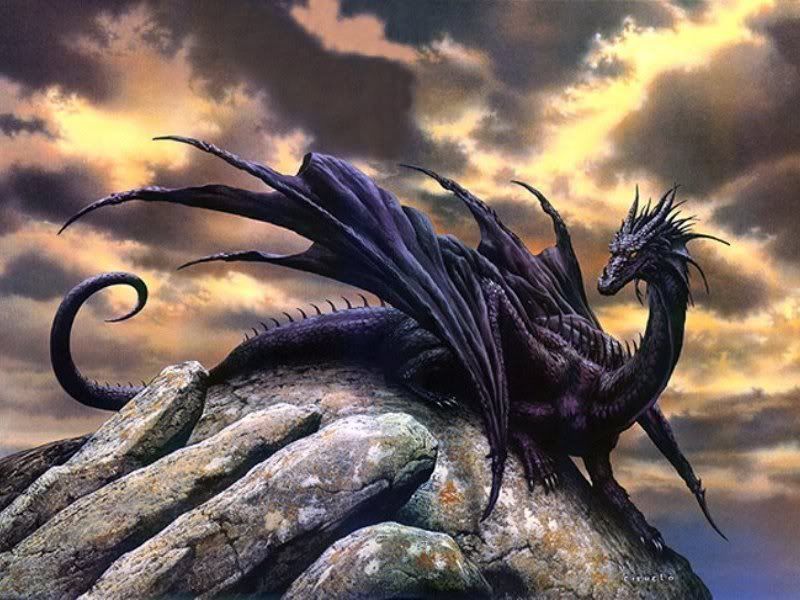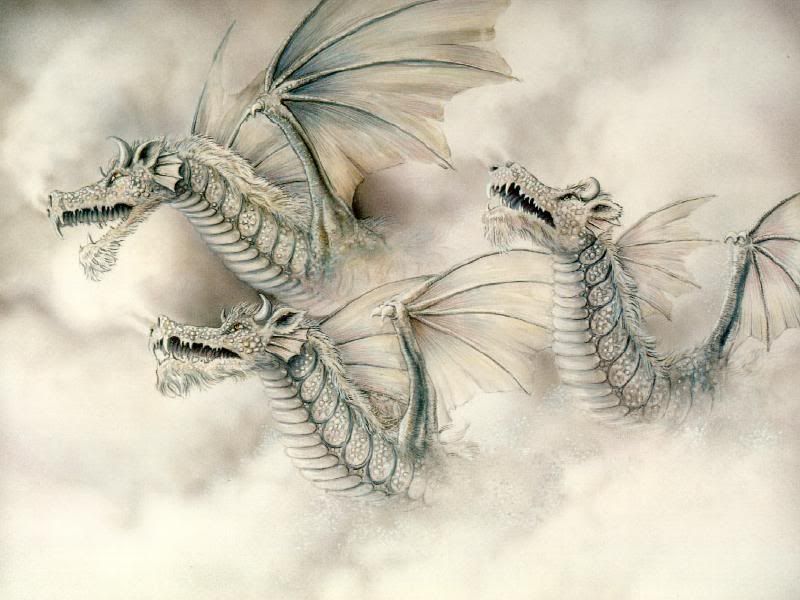I just love dragons thats way i created this little web page. Source for many information found here are form wikipedia or from some other sites. Pictures are form google. I hope you will enjoy in this page and in learning of draon way of life  .
.
The dragon
is a mythical creature typically depicted as a large and powerful serpent or other reptile with magical or spiritual qualities. Mythological creatures possessing some or most of the characteristics typically associated with dragons are common throughout the world's cultures.

Dragons are commonly portrayed as serpentine or reptilian, hatching from eggs and possessing extremely large, typically scaly, bodies; they are sometimes portrayed as having large eyes, a feature that is the origin for the word for dragon in many cultures, and are often (but not always) portrayed with wings and a fiery breath. Some dragons do not have wings at all, but look more like long snakes. Dragons can have a variable number of legs: none, two, four, or more when it comes to early European literature. Modern depictions of dragons are very large in size, but some early European depictions of dragons were only the size of bears, or, in some cases, even smaller, around the size of a butterfly.
Although dragons (or dragon-like creatures) occur commonly in legends around the world, different cultures have perceived them differently. Chinese dragons (Simplified Chinese: 龙; Traditional Chinese: 龍; pinyin: lóng), and Eastern dragons generally, are usually seen as benevolent, whereas European dragons are usually malevolent (there are of course exceptions to these rules). Malevolent dragons also occur in Persian mythology (see Azhi Dahaka) and other cultures.
Dragons are particularly popular in China. Along with the phoenix, the dragon was a symbol of the Chinese emperors. Dragon costumes manipulated by several people are a common sight at Chinese festivals.
Dragons are often held to have major spiritual significance in various religions and cultures around the world. In many Eastern and Native American cultures dragons were, and in some cultures still are, revered as representative of the primal forces of nature and the universe. They are associated with wisdom—often said to be wiser than humans—and longevity. They are commonly said to possess some form of magic or other supernormal power, and are often associated with wells, rain, and rivers. In some cultures, they are said to be capable of human speech. They are also said to be able to talk to all animals.
Dragons are very popular characters in fantasy literature, role-playing games and video games today.
The term dragoon, for infantry that move around by horse yet still fight as foot soldiers, is derived from their early firearm, the "dragon", a wide-bore musket that spat flame when it fired, and was thus named for the mythical creature.

Speculation on the origins of dragons
It has been suggested that legends of dragons are based upon ordinary creatures coupled with common psychological tendencies amongst disparate groups of humans.
Some believe that the dragon may have had a real-life counterpart from which the various legends arose — typically dinosaurs or other archosaurs are mentioned as a possibility — but there is no physical evidence to support this claim, only alleged sightings collected by cryptozoologists. In a common variation of this hypothesis, giant lizards such as Megalania are substituted for the living dinosaurs. Some believe dragons are mental manifestations representing an assembly of inherent human fears of reptiles, teeth, claws, size and fire in combination. All of these hypotheses are widely considered to be pseudoscience.
Dinosaur and mammalian fossils were occasionally mistaken as the bones of dragons and other mythological creatures — a discovery in 300 BC in Wucheng, Sichuan, China, was labeled as such by Chang Qu.[5] It is unlikely, however, that these finds alone prompted the legends of such monsters, but they may have served to reinforce them.
It has also been suggested by proponents of catastrophism that comets or meteor showers gave rise to legends about fiery serpents in the sky.[citation needed] In Old English, comets were sometimes called fyrene dracan or fiery dragons. Volcanic eruptions may have also been[citation needed] responsible for reinforcing the belief in dragons, although instances in Europe and Asian countries were rare.

Flag of Wales
Notable dragons
In myth
Azhi Dahaka was a three-headed demon often characterized as dragon-like in Persian Zoroastrian mythology.
Similarly, Ugaritic myth describes a seven-headed sea serpent named Lotan.
The Hydra of Greek mythology is a water serpent with multiple heads with mystic powers. When one was chopped off, two would regrow in its place. This creature was vanquished by Heracles and his cousin.
Smok Wawelski was a Polish dragon who was supposed to have terrorized the hills around Kraków in the Middle Ages.
Y Ddraig Goch is now the symbol of Wales (see flag, above), originally appearing as the red dragon from the Mabinogion story Lludd and Llevelys.
Nidhogg, a dragon in Norse mythology, was said to live in the darkest part of the Underworld, awaiting Ragnarok. At that time he would be released to wreak destruction on the world.
Orochi, the eight-headed serpent slain by Susanoo in Japanese mythology
In literature and fiction
The Old English epic Beowulf ends with the hero battling a dragon.Dragons remain fixtures in fantasy books, though portrayals of their nature differ. For example, Smaug, from The Hobbit by J. R. R. Tolkien, who is a classic, European-type dragon; deeply magical, he hoards treasure and burns innocent towns. Contrary to most old folklore and literature J. R. R. Tolkien's dragons are very intelligent and can cast spells over mortals.
A common theme in literature concerning dragons is the partnership between humans and dragons. This is evident in Dragon Rider and the Inheritance Trilogy. Most notably it is featured in Anne McCaffrey's Dragonriders of Pern series.
Dragons have been portrayed in several movies of the past few decades, and in many different forms. In Dragonslayer (1981), a "sword and sorcerer"-type film set in medieval Britain, a dragon terrorizes a town's population. In contrast, Dragonheart (1996), though also given a medieval context, was a much lighter action/adventure movie that spoofed the "terrorizing dragon" stereotype, and depicts dragons as usually good beings, who in fact often save the lives of humans. Dragons can also be passionate protectors, just like the dragon in Shrek and Shrek 2, who displays her affection for a donkey. Reign of Fire (2002), also dark and gritty, dealt with the consequences of dormant dragons reawakened in the modern world.
Dragons are common (especially as non-player characters) in Dungeons & Dragons and in some computer fantasy role-playing games. They, like many other dragons in modern culture, run the full range of good, evil, and everything in between. See Dragon (Dungeons & Dragons) for additional information.
On the lighter side, Puff the Magic Dragon was first a poem, later a song made famous by Peter, Paul and Mary, that has become a pop-culture mainstay.
As emblems
The dragon is the emblem of Ljubljana, Slovenia. The city has a dragon bridge which is embellished with four dragon depictions. The city's basketball club is nicknamed the "Green Dragons". License plates on cars from the city also feature a dragon depiction.
Y Ddraig Goch (IPA: [ə ðraig gox]) (Welsh for the red dragon) appears on the national Flag of Wales (the flag itself is also called the "Draig Goch"), and is the most famous dragon in Britain. There are many legends about y Ddraig Goch.
The dragon is also in the emblem of FC Porto, a sports club from Portugal, which is nicknamed "Dragões" (Dragons). Their football stadium is also nicknamed "Estádio do Dragão" (Dragon Stadium) and has a large bronze Dragon logo at the entrance.